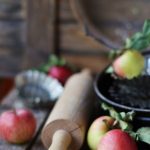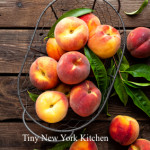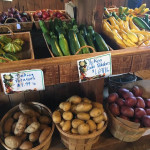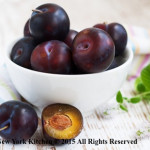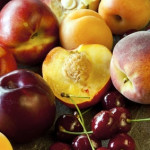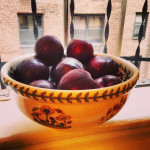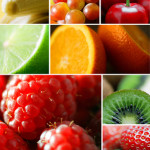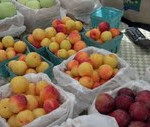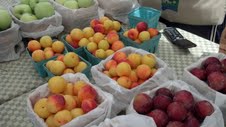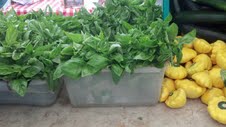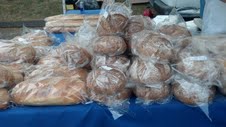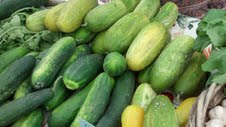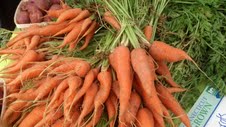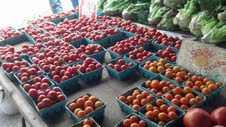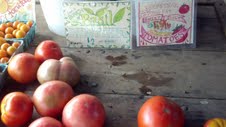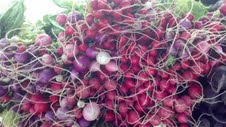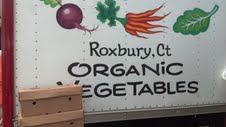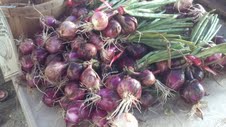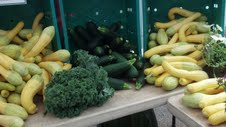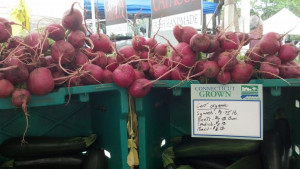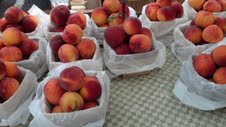Autumn’s bounty is vibrant, varied, and delicious. Apples of all varieties are now available at farmers’ markets and supermarkets, including crunchy, sweet Honeycrisp, gorgeous Galas, MacIntosh mottled with both green and red, pale yellow Ginger Golds, and dark, dusky Paula Reds.
Apples are the perfect snack, satisfying and sweet. Try slicing an apple, place the slices in a plastic baggie, sprinkle liberally with cinnamon, close the bag, and shake until the slices are well coated with cinnamon. The apple slices will stay crisp and white for several days in the refrigerator. Perfect for grab and go school lunches, picnics or work from home snack breaks.
A versatile cooking ingredient, apples go well with both sweet and savory components. Combing apples with plums, cranberries, figs, raspberries or blueberries will yield particularly pleasing desserts, such as pies, puddings, tarts, cobblers, and crisps. Whether baked, poached or sautéed, apples lend marvelous layers of flavor to breads, sauces, slaws, salads, stuffing, coleslaw, chutney, and relishes.
As the weather turns cooler, what could be more comforting than the scent of apples roasting in the oven, mingling with spicy cinnamon. Apples enjoy an easy association with all manner of spices, including allspice, cloves, ginger, and nutmeg.
©Tiny New York Kitchen © 2020 All Rights Reserved
Stone fruit is at its peak during the summer.
Look for fruit without any bruises, cuts, or soft spots.
Peaches bruise easily – hold in the palm of your hand to check ripeness instead of squeezing.
Give a sniff. Ripe fruit has a fragrant scent that makes you want to take a bit.
Ripen peaches by storing in a paper bag for 2 to 3 days at room temperature out of direct sunlight.
Keep cherries in the refrigerator.
All stone fruits offer good-for-you fiber and antioxidants.
Stone fruits are low in calories.
Peaches are a great source of vitamins A and C.
“Work With What You Got!”
©Tiny New York Kitchen © 2019 All Rights Reserved
September
September is a wonderful time for enjoying the beautiful array at local farmers’ markets. September is a delightful time for gathering ingredients that will showcase fleeting flavors of summer. A walk among colorful baskets filled with fresh produce is incredibly inspiration.
Blazing scarlet tomatoes, sun-sweetened and fattened from their time on the vine, are joined by zesty green, bright yellow, and almost purple-colored varieties. Turn this beautiful rainbow into a final summer tomato salad by simply cutting thick slices of each colorful variety of tomato, and arranging them on a big platter. Drizzle the slices with olive oil and balsamic vinegar, sprinkle with a bit of sea salt, and finish the dish with finely minced basil.
Fill your shopping cart with crisp cucumbers, glossy purple or creamy white eggplant, pale green or buttery yellow summer squashes, string or wax beans, spicy jalapeno peppers, fragrant peaches, lush melons, sugary corn on the cob and great bunches of finely scented fresh herbs.
As September evenings grow quietly cooler, take pleasure in preparing dishes that feature these ingredients, such as nutmeg-scented roasted peaches, a delectable eggplant parmesan, velvety corn soup, garlic string beans or summer squash stuffed with ground lamb or turkey, breadcrumbs, fresh basil, oregano and parsley, cinnamon and bit of cheese. Cucumbers can be turned into simple refrigerator pickles, jalapeños can be roasted on the grill and packed away in the freezer, ensuring that a bit of summer will still be served as the season marches on.
There is also a hint of fall to be found at the farmers’ market. While all of the summer crops are still available to be savored, the new season is sneaking in. Freshly dug potatoes, dark purple plums, crisp early apples, succulent pears, Brussels sprouts, earthy mushrooms, carrots, cauliflower and kale will provide culinary creativity for weeks to come.
Cooking and eating with the seasons is the most excellent and efficient way to introduce high quality nutrients into the body. When we enjoy what nature has prepared for us, we are giving our bodies the gift of exceptionally luscious flavor, along with important healing properties. I can’t think of a better way to prepare a delicious life.
www.tinynewyorkkitchen.com
“Work With What You Got!”
© Victoria Hart Glavin Tiny New York Kitchen © 2016 All Rights Reserved
5 Ways To Make The Most Of Plums
RAW
Pit and thinly slice for Spinach Salad with Plums and Goat Cheese
BAKED
Stone fruit crumbles, cobblers and crisps are hallmarks of late summer. Swap in plums for other stone fruits in your favorite recipes.
ROASTED/GRILLED
Roasting and grilling fruit brings out its inherent sweetness. Serve with crème fraiche, ice cream, or yogurt.
CANNED
Preserve plums by making jam, chutney, salsa, or a spicy sauce to enjoy the taste of summer year round.
DRIED
Dry slices in a low temperature oven for a sweet, chewy on the go snack, which are perfect for packed lunches.
“Work With What You Got!”
© Victoria Hart Glavin Tiny New York Kitchen © 2015 All Rights Reserved
5 Ways to Make the Most of Seasonal Stone Fruit
Ripen: Ripen peaches, nectarines and apricots at room temperature. Once ripe, they can be refrigerated for just a few days to help keep them at their best.
Speed Up: Speed up the ripening process by placing fruit in a brown paper bag on the counter, checking a few times each day.
Can: Preserve stone fruits by canning them (make jam, syrup or salsa) to enjoy the taste of summer year-round.
Dry: Bake or grill halves or slices at 200 degrees for about 3 hours, turning every 30 minutes or so, until dehydrated yet still soft. Store in the refrigerator.
Freeze: Lightly poach halved and pitted fruit in water (sugar optional), portion and freeze for later use in smoothies, baking, desserts or fruit sauce for pancakes.
“Work With What You Got!”
© Victoria Hart Glavin Tiny New York Kitchen © 2015 All Rights Reserved
I love plums and am thinking of making a plum crisp or some other type of plum dessert. Meanwhile they sit on my windowsill just looking pretty.
Have you ever come home from the market after purchasing fruit to find that you spent money for nothing? I have plenty of times and it ticks me off every time. Here are some Fruit Essentials that may help you have more fruit shopping success.
Did you know that many plants that are botanically fruits are not sweet? We think of them as vegetables or non-fruits. Avocados, beans, coconuts, corn, cucumbers, eggplants, green peppers, okra, peas, pumpkins, sugar peas, string beans and tomatoes all fall in the fruit category. Some cookbooks make a distinction between fruit, vegetables and fruit vegetables. Fruit vegetables are foods that are botanically fruits, but are most often prepared and served like vegetables. These fruits are considered fruit vegetables: Aubergine, autumn squash, avocado, bitter melon, cantaloupe, chayote, chile, courgette, cucumber, eggplant, gherkin, green bean, green sweet pepper, hot pepper, marrow, muskmelon, okra, olive, pumpkin, red sweet pepper, seedless cucumber, squash, sweet pepper, tomatillo, tomato, watermelon, wax gourd, yellow sweet pepper and zucchini.
Pectin is a substance contained in some fruit which is used for making jams and jellies thicker. High pectin fruits are apples, cranberries, currants, lemons, oranges, plums and quinces. Low pectin fruits are bananas, cherries, grapes, mangos, peaches, pineapples and strawberries.
Low pectin fruits seem to discolor quicker than high pectin fruits ( bananas and eggplants). Lemon juice or vinegar slows the discoloring process. Other fruits and vegetables that discolor quickly are avocados, cauliflower, celery, cherries, figs, Jerusalem artichokes, mushrooms, nectarines, parsnips, peaches, pears, potatoes, rutabaga and yams.
Bruising: When a fruit is bruised the cell walls break down and discoloration begins. The process can be slowed down by refrigeration.
Cleaning: It is important to clean our fruit and vegetables. Rinse fruit in cold running water and scrub as needed before cooking or eating. Soaking fruit in water for more than a few minutes can leach out water soluble vitamins.
Peeling: The fruit skin usually contains a lot of important nutrients, but if you need to peel a thick-skinned fruit cut a small amount of the peel from the top and bottom. Then on a cutting board cut off the peel in strips from top to bottom. A good way to peel thin skinned fruit is to place the fruit in a bowl with boiling water and let stand for about 1 minute. Remove and cool in an ice water bath. You could also spear the fruit with a fork and hold over a gas flame until the skin cracks OR quarter the fruit and peel with a sharp paring knife or potato peeler.
Wax: Oh those beautiful waxed apples that wink at us at the market. They are beautiful because they are waxed. I don’t know about you, but I would rather not eat wax. Wax can be removed from the surface of fruits by washing them with a mild dishwashing soap and then thoroughly rinsing them. This will remove most of the wax, but probably not all of it.
Purchasing Ripe: Purchase these fruits fully ripe: Berries, cherries, citrus, grapes and watermelon. All of the fruits in this list, except berries, can be refrigerated without losing flavor.
Purchasing Not-So-Ripe: Apricots, figs, melons, nectarines, peaches and plums develop more complex flavors after picking. Store these fruits at room temperature until they are as ripe as you would like them.
Refrigeration: You can refrigerate apples,ripe mangos and ripe pears as soon as you get them. Do not refrigerat bananas.
Seasonal Fruit: Winter is the season for citrus. Fall is the season for apples and pears. Late spring is the season for strawberries and pineapples. Summer is perfect for blueberries, melons, peaches and plums.
Washing: Dry fruit with paper towels or kitchen towels and then use a blow dryer on the cool setting to completely dry fruit.
Squeezing: A microwave can be used to get more juice from citrus fruits. Microwave citrus fruits for about 20 seconds before squeezing the fruit for juice.
I love going to farmers' markets, especially good ones. It's the closest to "farm to table" that I can get without growing my own fruits and vegetables. Yesterday was my first visit to the New Canaan farmer’s market. It’s a good one! I picked up beets, radishes, tomatoes, cucumbers, onions, peaches and plums. Everything looked great and even though the vendors were busy they were very friendly and seemed happy to be there.
New Canaan Farmers’ Market
Saturday 10am to 2pm
May 12th Through October
Old Center School Parking Lot
South Avenue & Maple Street
www.newcanaanfarmersmarket.net

